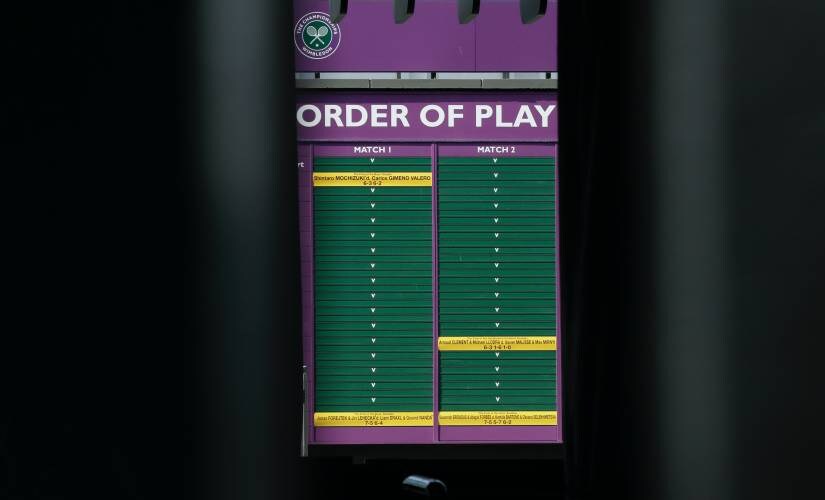Does it ever happen with you that the mere sight of something makes all your other senses come alive, creating an immersive experience that somehow circumvents the boundaries of time and space? Tennis fans will tell you that Wimbledon’s Centre Court can have that effect on pretty much anyone who is capable of emotion. [caption id=“attachment_8221361” align=“alignnone” width=“825”]  An order of play sign inside Wimbledon, which was cancelled on Wednesday. AP[/caption] The arrival of first practice clips from Wimbledon every June always feel like manna from heaven. After two months of gruelling clay court tennis in an unforgivable environment, the ball skipping softly along the lush green lawns is truly a sight for sore eyes. The TV promos (hat tip to the marketing team of the All England Club here) do a fine job of upholding the tournament’s aura too. When you see a clip of Roger Federer dancing across the turf to the background of orchestral music, you are transported to a different realm altogether – a realm you never want to leave. You can almost smell the freshly cut grass, taste the strawberries and cream, and touch the air of opulence that surrounds Centre Court. It’s like you are there in SW19, soaking in the ever-constant gravitas that the tournament brings to the sporting universe.
As have we found out now though, the presence of Wimbledon in our lives isn’t as constant as we thought. The All England Club announced on Wednesday that the **2020 edition of the tournament has been cancelled** due to the COVID-19 pandemic. It was a reminder – like we even needed one – that the virus isn’t going to stop sucker-punching our lifeless bodies any time soon. That the life is being drained out of us cough-by-cough is undeniable. There is no way to look past the devastation that coronavirus has caused across the world; it is taking lives almost by the minute, leaving entire nations crippled and defeated. The Wimbledon organisers had no option but to pull the plug given the particularly dire situation in the UK, and it goes without saying that every player and every fan would readily agree with their decision. Health and life take precedence over everything. We are all seeing the unspeakable havoc the virus is wreaking everywhere, and we all want it to stop before it gets to a stage where we lose touch with our humanity. In that context, cancelling a sports tournament seems like a small price to pay. Also Read: What does cancellation of Wimbledon mean for tennis in 2020? But given the mental state most of us are in right now, the announcement by the All England Club still came as a dagger to the heart. Sport unites and uplifts people in times of duress, and as a species we have rarely been in as much duress as we are today. Yet in a cruel twist of fate, we are being deprived of the one thing that can help us deal emotionally with the crisis. We are at war right now, but unlike the other wars of our time, we don’t have sport to turn to for solace. It’s like being slapped by a bully, and then not even being allowed to go home and cry. [caption id=“attachment_8221381” align=“alignnone” width=“825”]  Strawberries and cream are part of the Wimbledon tradition. They would be missing in 2020. AP[/caption] Yes, Wimbledon has been cancelled before. But the last time it happened, a man called Adolf Hitler was on the rampage; it took a freakin’ World War to make the All England Club forego its prized jewel. In the 75 years since, the tournament has continued uninterrupted – a symbol of the enduring power of tradition, and a safe haven for those in need of some high-quality distraction. Wimbledon has also been a seasonal emblem, although of a different kind in different places. In UK and the rest of the western world it represents the peak of summer, a time when everything is bright and warm and full of life. The strawberries and Pimm’s aren’t ubiquitous just because of tradition; they are also things that anyone would want to have when they’re in a good mood. In other words, Wimbledon translates to summery happiness for Londoners, even with all the aristocratic vibes around SW19. In India and other tropical countries, the tournament coincides with the start of the rainy season. The greenery of the grounds mirrors the relief that most Asians coming off the scorching May-June feel when the heavens open up. And that is probably why even the occasional rain delays (on courts without a roof) don’t bother us too much. Wimbledon amid the rains is a time-tested habit for tennis fans everywhere. It’s our own cup of joy; something we value so greatly that we almost don’t want to share it with the rest of the world. The spectacular grass, the well-dressed spectators, the lights under the roof, the polite but firm applause, the all-white outfits, the (Roger) Federer backhand, the (Novak) Djokovic sprint, the Serena (Williams) serve – every single element that makes up the Wimbledon package is a treasure on its own, and plays a big part in shaping the tennis calendar. Which is why the thought of not having any of it this year is almost too miserable for words. We will get to experience it again, and hopefully the romance of the tournament will return in full force come June 2021. But for now, all we can do is look wistfully at old pictures of the manicured lawns and lament at how much coronavirus is taking from our spirit.


)

)
)
)
)
)
)
)
)



